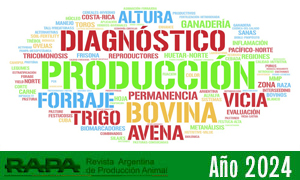Ver ítem
- xmlui.general.dspace_homeCentros Regionales y EEAsCentro Regional La Pampa - San LuisEEA AnguilArtículos científicosxmlui.ArtifactBrowser.ItemViewer.trail
- Inicio
- Centros Regionales y EEAs
- Centro Regional La Pampa - San Luis
- EEA Anguil
- Artículos científicos
- Ver ítem
Altura de corte en alfalfa: producción y calidad nutritiva del forraje = Cutting height in alfalfa: production and nutritional quality of forage
Resumen
En pasturas de Medicago sativa (alfalfa) sometidas a defoliaciones frecuentes, aumentar la altura remanente después del corte suele mejorar la productividad, aunque esto puede influir en la calidad nutritiva del forraje cosechado. En este estudio, se
analizaron los cambios en el crecimiento aéreo, el forraje cosechado y la calidad nutritiva asociados con dos alturas remanentes (4 cm vs. 10 cm) en dos cultivares de alfalfa con diferentes grados de
[ver mas...]
En pasturas de Medicago sativa (alfalfa) sometidas a defoliaciones frecuentes, aumentar la altura remanente después del corte suele mejorar la productividad, aunque esto puede influir en la calidad nutritiva del forraje cosechado. En este estudio, se
analizaron los cambios en el crecimiento aéreo, el forraje cosechado y la calidad nutritiva asociados con dos alturas remanentes (4 cm vs. 10 cm) en dos cultivares de alfalfa con diferentes grados de latencia invernal (G6 vs. G10). Se trabajó en contenedores al
aire libre, dispuestos para simular una pastura de 50 plantas/m2, bajo condiciones no limitantes en disponibilidad de agua y nutrientes. Entre noviembre de 2014 y setiembre de 2015 se realizaron defoliaciones a 4 y 10 cm de altura, cada 370 grados día de crecimiento (GDD). Se registró altura de canopia, número de hojas primarias totalmente expandidas, biomasa aérea cosechada (BACOS) y remanente (BAREM_verde). La BACOS fue separada en hojas (BAHOJA, láminas+pecíolos) y tallos (BATALLO), y se estimó la proporción de hojas (PROPHOJA = BAHOJA/BACOS). Se determinó digestibilidad de materia seca (DMS) de hojas (DMSHOJAS), tallos (DMSTALLOS) y de BACOS (DMSCOS). Las plantas cortadas a 10 cm de altura mostraron mayor crecimiento aéreo (BACOS + BAREM_verde) y mayor BAREM_verde que las cortadas a 4 cm, pero no se encontraron diferencias en BACOS, sin detectarse diferencias entre cultivares.
No se detectaron diferencias en DMS para plantas cortadas a distintas alturas. El cultivar G10 mostró, respecto del G6, menor DMSCOS y menor DMSTALLOS, no encontrándose diferencias entre cultivares en DMSHOJAS. Se observo una estrecha y negativa asociación entre altura de canopia, PROPHOJA, DMSCOS y DMSTALLOS. Esta asociación explica la menor DMS obtenida en el cultivar G10. En ambos cultivares, incrementar la altura de corte (4 a 10 cm) produjo un incremento en crecimiento aéreo, sin modificar la cantidad y digestibilidad del forraje cosechado.
[Cerrar]
In Medicago sativa (alfalfa) pastures defoliated at a high frequency, increasing the remaining post-cutting height usually increases productivity, which can generate changes in the nutritional quality of the harvested forage. Changes in aerial growth, harvest and nutritional quality associated to changes in the remaining post-cutting height (4 cm vs. 10 cm) were analyzed in two contrasting winter dormant cultivars of Medicago sativa (lucerne) (G6 vs.
[ver mas...]
In Medicago sativa (alfalfa) pastures defoliated at a high frequency, increasing the remaining post-cutting height usually increases productivity, which can generate changes in the nutritional quality of the harvested forage. Changes in aerial growth, harvest and nutritional quality associated to changes in the remaining post-cutting height (4 cm vs. 10 cm) were analyzed in two contrasting winter dormant cultivars of Medicago sativa (lucerne) (G6 vs. G10). The experiment was conducted in outdoor pots, arranged to simulate a pasture of 50 plants/m2under non-limiting water and nutritional conditions. Between November 2014 and September 2015, defoliations were carried out at 4 and 10 cm in height, every 370 growing degree days (GDD). Canopy height, number of
fully expanded primary leaves, aerial biomass above (BACOS) and below (BAREM_verde) the cutting height were recorded. The BACOS was separated into leaves (BAHOJA, blades + petioles) and stems (BATALLO), and leaf proportion was estimated (PROPHOJA =
BAHOJA/BACOS). Dry matter digestibility (DMS) of leaves (DMSHOJAS), stems (DMSTALLOS) and BACOS (DMSCOS) was determined. Plants cut at 10 cm in height showed greater aerial growth (BACOS + BAREM_verde) and greater BAREM_verde than plants cut at 4 cm, but no differences were found in BACOS, with no differences detected between cultivars. No differences in DMS were detected for plants cut at different heights. Cultivar G10 showed both, lower DMSCOS and DMSTALLOS tan cultivar G6, but no differences were detected in DMSHOJAS. A close and negative association between canopy height and several forage quality parameters (PROPHOJA, DMSCOS and DMSTALLOS) was detected. This association explains the lower DMS obtained in the G10 cultivar. In both cultivars, increasing the cutting height (4 to 10 cm) produced an increase in aerial growth, without generating changes in the quantity and digestibility of the harvested forage.
[Cerrar]

Fuente
Revista Argentina de Producción Animal 44 (2) : 59-68 (2024)
Fecha
2024-12
Editorial
Asociación Argentina de Producción Animal
ISSN
0326-0550
2314-324X
2314-324X
Documentos Relacionados
Formato
pdf
Tipo de documento
artículo
Proyectos
(ver más)
INTA/2023-PD-L01-I098, Producción ecoeficiente de forraje en pasturas y pastizales
Palabras Claves
Derechos de acceso
Abierto
 Excepto donde se diga explicitamente, este item se publica bajo la siguiente descripción: Creative Commons Attribution-NonCommercial-ShareAlike 2.5 Unported (CC BY-NC-SA 2.5)
Excepto donde se diga explicitamente, este item se publica bajo la siguiente descripción: Creative Commons Attribution-NonCommercial-ShareAlike 2.5 Unported (CC BY-NC-SA 2.5)


